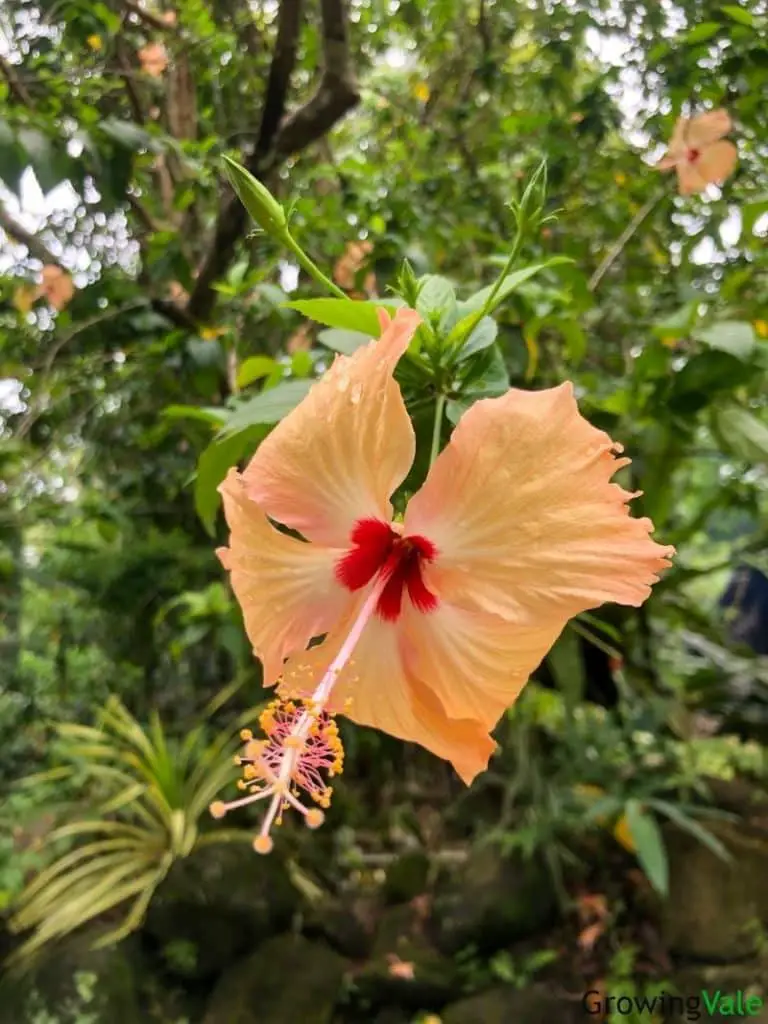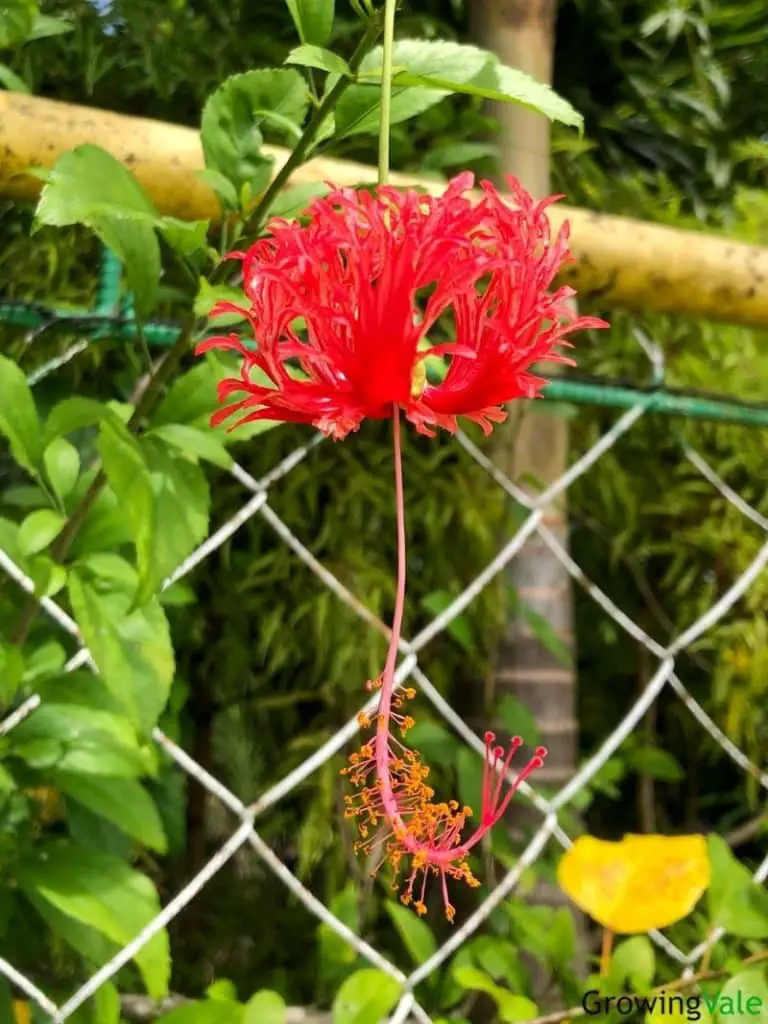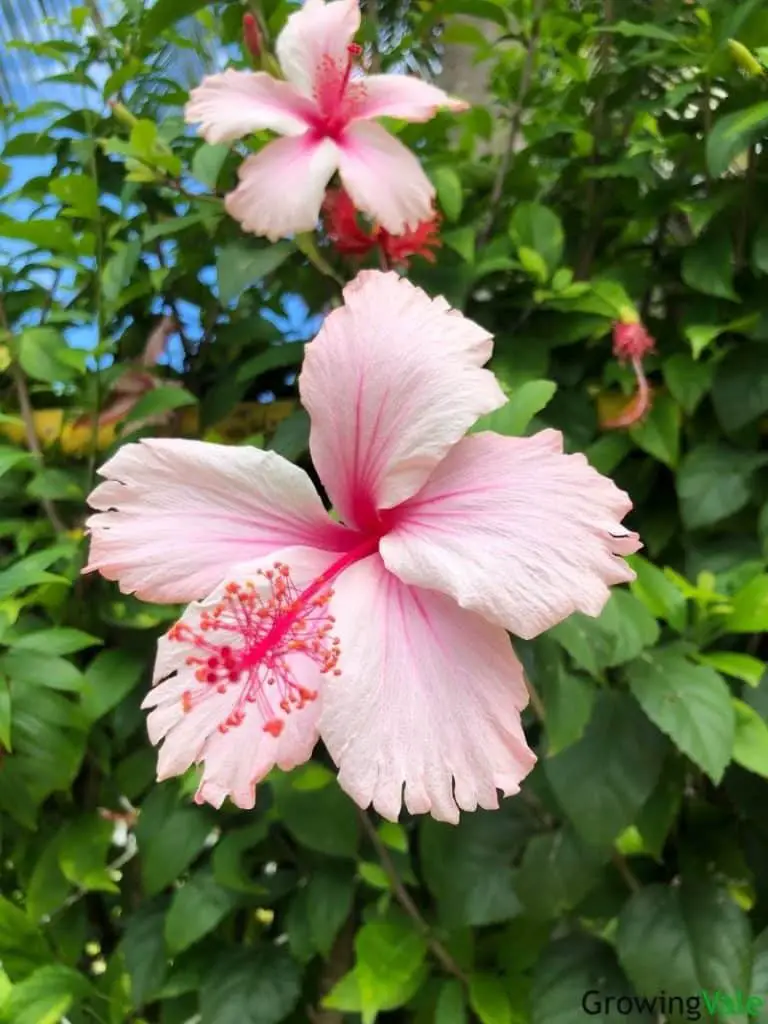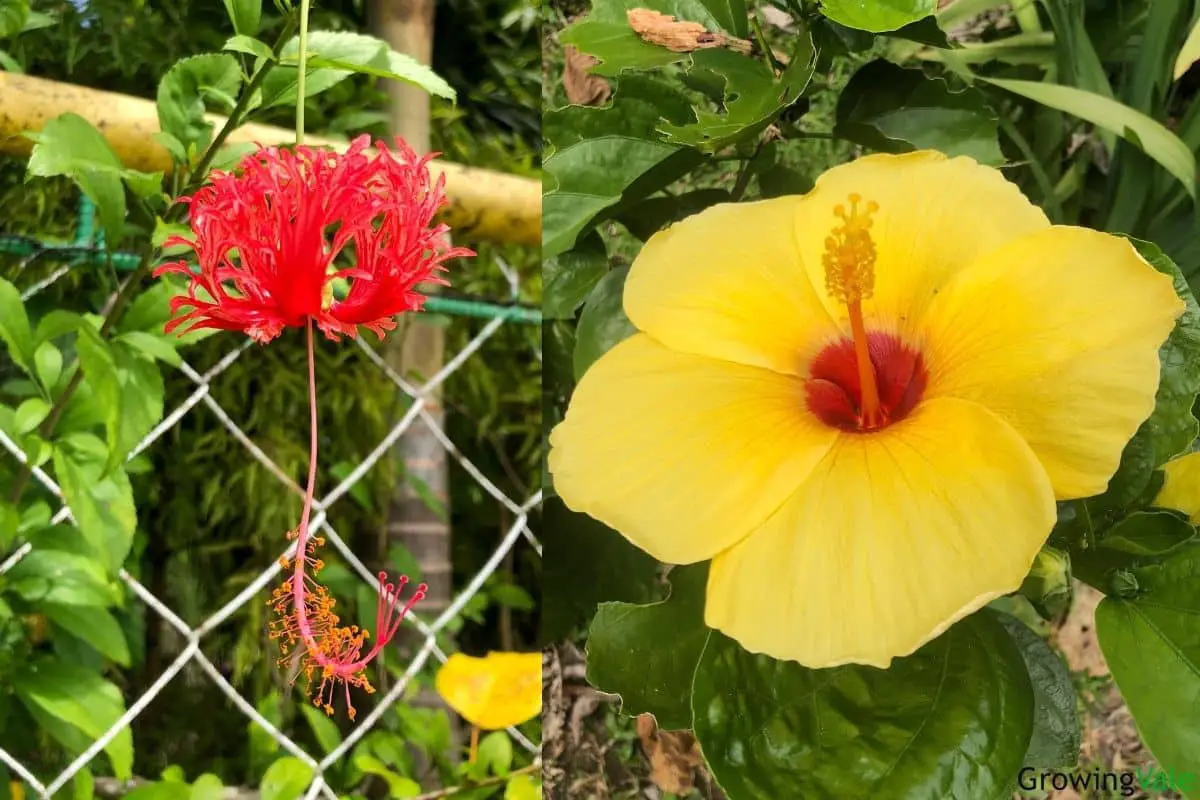Hibiscus rosa-sinensis, also known as Tropical Hibiscus or Chinese Hibiscus is an evergreen shrub with characteristic large, funnel-shaped flowers. This plant is very popular among growers as flowers can range from 2-10 inches in diameter and come in a variety of bright and eye-catching colors.
Native to China, tropical Asia, and the Pacific Islands, this plant requires warm temperatures and is winter hardy to USDA zones 9-11. When grown outdoors Tropical Hibiscus makes a very attractive hedge or centerpiece for any garden as it blooms continuously throughout the year. Potted specimens which are overwintered indoors bloom from spring through to summer.
History and Fun Facts
Although the exact origins of Hibiscus rosa-sinensis are unknown, long-term cultivation has been shown in China, Japan, and the Pacific Islands. Cultivation in Europe has been dated as far back as 1731.
The origin of the taxonomic name can be directly translated as meaning “rose of China”, rosa (meaning rose) sinensis (meaning from China). Many of the hibiscus plants seen today are the result of cross-breeding varieties to create different colors and sizes of flowers.
Hibiscus rosa-sinensis has been the national flower of Malaysia since 1960. Known locally as Raya Bunga, each flower has five petals which are said to represent the five national principles of Malaysia’s government. The most common color of Tropical Hibiscus (red) is said to represent the courage of the Maylasian people.
| Scientific name | Hibiscus rosa-sinensis |
| Common names | Tropical Hibiscus, Chinese Hibiscus, China Rose, Hawaiian Hibiscus, Shoe-Black Plant |
| Genus | Hibiscus |
| Family | Malvaceae |
| Height | 4 ft. 0 in. – 10 ft. 0 in |
| Width | 5 ft. 0 in. – 8 ft. 0 in. |
| USDA Plant Hardiness Zone | 9b, 9a, 10b, 10a, 11b, 11a |
| Native to | China, Tropical Asia, Pacific Islands |
| Flower colors | Red, Pink, Yellow, Orange, White, Multi-colored |
| Plant-specific features | Large, colorful, funnel-shaped flowers |

How to Plant and Grow Hibiscus Flower
There are many types of hibiscus you can grow. Tropical Hibiscus plants can be grown either outdoors in a flower bed or plant pot.
In colder climates, potted plants are ideal as they can be easily transferred indoors for overwintering. It is possible to plant Hibiscus grown from seeds, propagated through cuttings, or to directly seed the ground.
Plants propagated from cuttings will be ready to plant either outdoors or in a container once roots have formed. Those grown from seed will be ready for transplantation once two true pairs of leaves have formed. Late spring to early summer is the best time for planting.
Growing Hibiscus Plant Outdoors
When growing Hibiscus trees outdoors, it is important to choose an area that receives sufficient sunlight and has enough space for the plant to grow. Dig a hole large enough to accommodate the new plant and gently ease the plant from its existing container and place it in the new hole 1 inch below the opening. Fill the surrounding area with soil and lightly but firmly pat the soil down. Water the plant thoroughly.

Growing Hibiscus Plant in a Pot
When growing Hibiscus plants in a pot, it is important to choose the right variety. While all varieties will grow easily in pots, many are fast growers and will quickly outgrow the container. Some varieties are also sensitive to overwatering and will require extra care.
Choosing a pot with more drainage holes is important to allow for sufficient drainage. Both plastic and clay pots have benefits and drawbacks – clay pots are less likely to overheat or retain too much water, but may only have one drainage hole and are fragile; whereas plastic pots retain more water and black plastic pots, in particular, may cause overheating when in direct sunlight.
To repot a plant, gently ease the old pot off the root ball. If roots are wrapping around each other, the plant requires a larger container.
If the plant is solidly rooted in the pot, it is possible to cut up to one-third of the root mass off to free the plant. Disturb the root ball to loosen the roots slightly and place the plant in the new pot. The top of the root ball should be 1 inch below the rim of the new container. Fill in the soil to the top of the container pressing firmly but lightly. Water the plant thoroughly.

Care and Maintenance
Here are some important hibiscus care tips:
Soil
Hibiscus plants prefer rich, well-drained slightly acidic soils. For sandy soils, increase water retention by thoroughly mixing with heavily decomposed organic matter. In clay soil types, consider using raised beds to avoid plants being in excessive moisture for long periods.
For potted plants, good drainage is also key. Use a potting mix consisting of a combination of 5% perlite, 50% coco coir and 45% composted hardwood bark. If coco coir is unavailable, substitute for 50% peat, however, coco coir is preferable as it is less likely to pack and longer-lasting.
Water
Water these plants well and regularly especially during the growing season (spring through summer for potted plants, year-round for outdoor plants). If being grown in pots, take care not to overwater – water until there is water flowing out from the drainage holes, then allow the potting medium to dry out before watering again.
In the winter months, water in the morning allows the plants to dry out before temperatures decline overnight, as low oxygen levels and cold temperatures encourage fungal disease. Plants require less water during cooler months. Take care to water the root system directly and keep the foliage as dry as possible to limit diseases developing in the foliage.

Fertilizer
Grown outdoors, the Tropical Hibiscus flower requires regular fertilization when newly planted, but once established requires little care. Potted plants require light and regular fertilization during the growing season using water-soluble Hibiscus fertilizer every two weeks or slow-release Hibiscus fertilizer every 8 weeks.
During cooler months accompany reduced watering with reduced fertilization, overwintered plants can be left without fertilization unless nutrient deficiencies occur. Every 6 weeks, water plants with clean unfertilized water to flush out dangerous salt build-ups in the soil which can damage the plant.
Avoid regularly using fertilizers formulated to encourage flower blooming, as these contain phosphorus levels considered too high for Hibiscus plants to tolerate regularly. However, using these formulas in the summer months will encourage more blooms.

Sunlight
These tropical plants like as much sunlight as possible, ideally 6 or more hours of direct sunlight a day. However, they can tolerate partial shade (2-6 hours of direct sunlight a day). Less sunlight results in fewer and smaller flowers.
If overwintering indoors, place in an area of bright sunlight preferably near a southern or western facing window. Check plants for pests and diseases before bringing them indoors and treat them accordingly.
Temperature and Humidity
Tropical hibiscus prefers temperatures of above 50°F, and true to their tropical origins these plants cannot tolerate long spells of below-freezing weather. If temperatures are below 35°F the plant will sustain damage or even die. It is recommended to overwinter the plants indoors once nighttime temperatures fall below 50°F to protect them from damage.
These plants like high humidity environments, therefore place potted plants on top of a moist, pebble tray to increase humidity.
Pruning
Outdoor specimens require little pruning during the growing season if space is not an issue. However, plants grown 3-4 feet apart can be trained and pruned to form attractive hedges. Hibiscus flowers form on new growth so pruning the plant mid-spring and/or pinching tips from spring through early summer can encourage new growth and increased flower production. Heavy pruning will not damage the plant but it will delay blooming.
Potted plants grown indoors or outdoors with limited space may need to be pruned lightly and more regularly to maintain an attractive shape. Remove ⅓ of old wood by early spring to keep plants healthy and pinch tips to encourage new growth from spring through to summer.
Propagation
Propagation of Tropical Hibiscus trees can be done via cuttings, seeds, or grafting. Propagation by cuttings and seed are the most popular methods.
To grow the Hibiscus tree from seed, wait for the seed pod to mature (seed pod will be brown and beginning to split) and collect seeds before they have been ejected from the pod. Place in an envelope and put in a dry, cool area for a week for the seeds to dry out.
Sew seeds in summer with an ideal temperature of 80°F. Soak seeds for one hour in warm water before sewing them 0.5 inches deep in a light potting mix, in partial shade, and keeping the soil moist. Seeds should take 1-4 weeks to germinate.
To propagate the Hibiscus tree from cuttings, take 3-5 inch cuttings from new softwood growth, making sure the cut is below a leaf node and at a 45-degree angle to increase the surface area of the exposed stem. Strip off lower leaves and dip the end of the exposed stem in rooting hormone. Gently shake off excess rooting hormone and put cuttings 1-2 inches deep into a pot of light potting mixture, out of direct sunlight. Keep the potting mixture moist. Roots should form within 4-6 weeks.
Pest and diseases
The most common pests of the Tropical Hibiscus plant are aphids and spider mites. Inspect plants closely and treat with horticultural/insecticidal soap or prune infected branches. A hose with a strong water flow would also be suitable to dislodge the pests.
If leaf spots are seen, remove and destroy infected leaves. The Hibiscus tree can also suffer from Canker plant disease, which results in orange, red fruiting bodies causing irregular growths on the stem. Remove infected branches.
Other Things To Keep In Mind
Fluctuating temperatures, over or underwatering, and over-fertilization can cause bud drop – whereby unopened buds turn yellow and fall off the plant.
Uses of Hibiscus Plant
Hibiscus rosa-sinensis has long been cultivated as an ornamental plant due to the attractiveness of its flowers; however, this plant has also been utilized for several other reasons.
Records from the 19th and early 20th centuries show that the roots, leaves, and flowers of the plant were used by Malay and West Indies communities for medicinal purposes in treating fevers and various diseases. Recent studies also demonstrate the medicinal uses of the plant and it is now widely used by the cosmetics industry due to the anti-aging properties it possesses.
Hibiscus flower extract is widely used in the food industry as a flavoring agent in many products such as jams, sauces, and spices and can be brewed and drunk as herbal tea.
Conclusion
Hibiscus rosa-sinensis is a largely popular ornamental plant due to its bright and attractive flowers. Although tropical by nature, with the right care and attention, this vibrant, evergreen shrub can be grown in many parts of the world either indoors, outdoors, or a mixture of the two.
With a variety of uses ranging from medicinal to culinary, this plant is as useful as it is beautiful and would make a fantastic addition to anyone’s garden.
See more: Hibiscus Flower Meaning
*References
Reference list
Dr. Don C. Wilkerson, Dr. Wm. M. Johnson, Tropical Hibiscus (Hibiscus rosa-sinensis)
For Galveston County and the Texas Upper Gulf Coast https://aggie-horticulture.tamu.edu/galveston/educ_programs/Tropical-Hibiscus.pdf
Edward F. Gilman, Hibiscus rosa-sinensis https://hort.ifas.ufl.edu/database/documents/pdf/shrub_fact_sheets/hibrosa.pdf
Iowa College of Liberal Arts and Sciences, Hibiscus rosa-sinensis https://biology.uiowa.edu/facilities/greenhouse/plant/hibiscus-rosa-sinensis
Ishrat Mahmood Khan, Rafia Rahman, Ayesha Mushtaq and Meriam Rezgui, Hibiscus rosa-sinensis L. (Malvaceae): Distribution, Chemistry and Uses https://www.researchgate.net/profile/Rafia-Rehman/publication/336825435_Hibiscus_rosa-sinensis_L_Malvaceae_Distribution_Chemistry_and_Uses/links/5db3ff76299bf111d4c98ce7/Hibiscus-rosa-sinensis-L-Malvaceae-Distribution-Chemistry-and-Uses.pdf
Karen Russ, Hibiscus https://hgic.clemson.edu/factsheet/hibiscus/
Missouri Botanical Garden, Hibiscus rosa-sinens https://www.missouribotanicalgarden.org/PlantFinder/PlantFinderDetails.aspx?kempercode=b557
N.C. Cooperative Extension, Hibiscus rosa-sinensis https://plants.ces.ncsu.edu/plants/hibiscus-rosa-sinensis/
Smithsonian Gardens, Care of Hibiscus rosa-sinensis https://gardens.si.edu/learn/for-educators/plant-care-sheets/care-of-hibiscus-rosa-sinensis/
The New Orleans Chapter of the American Hibiscus Society, Hibiscus in Pots, Success with Container Culture http://people.loyno.edu/~gerlich/NOHS/Container_Growing.html
Thulaja, Naidu Ratnala, Hibiscus (Hibiscus rosa-sinensis) https://eresources.nlb.gov.sg/infopedia/articles/SIP_211_2005-01-09.html
University of Florida Environmental Horticulture, Hibiscus rosa-sinensis https://hort.ifas.ufl.edu/database/lppi/sp181.shtml
University of Minnesota Extension, Hibiscus https://extension.umn.edu/house-plants/hibiscus#common-problems-1440067
”Close”

